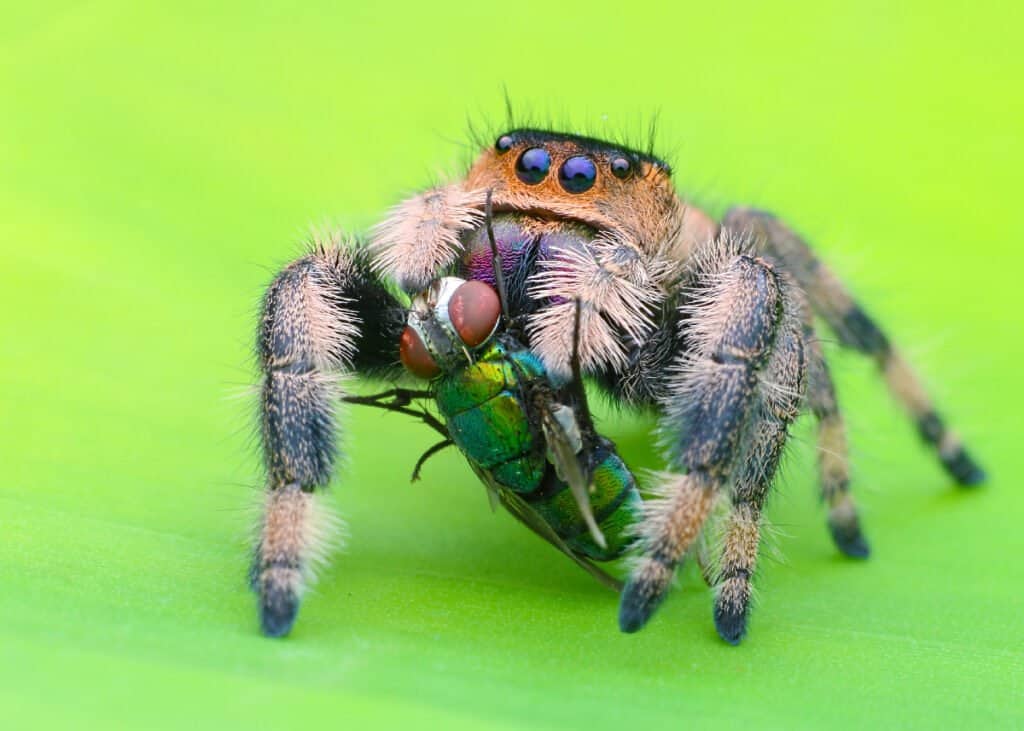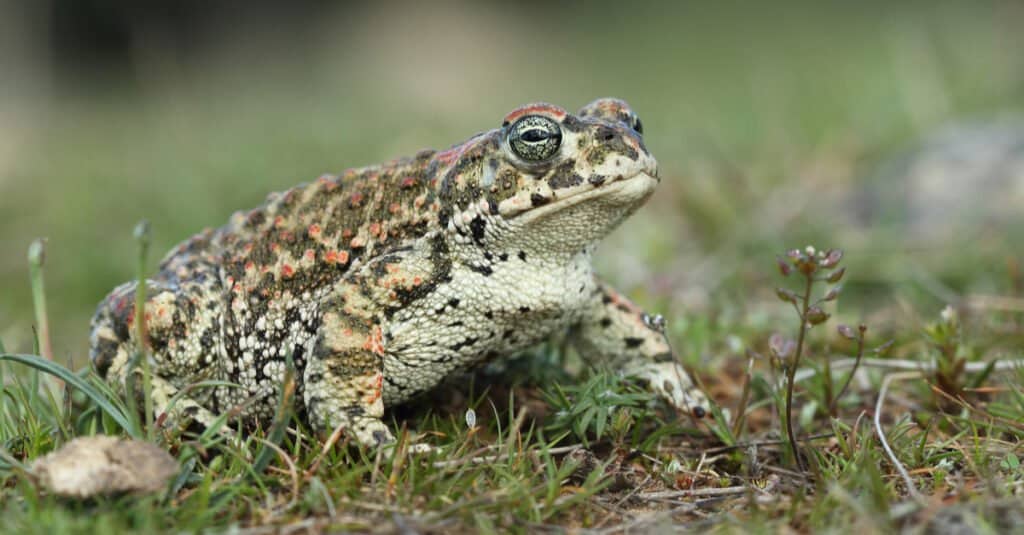Key Points:
- Archers, trout, and mosquitofish are rather partial to spiders that tumble into their watery domains.
- Lizards are capable of lowering existing spider populations significantly.
- Large spiders are by no means safe from predators either. Tarantulas for example are in constant danger of falling prey to tarantula wasps.
Spiders are tiny and somewhat intelligent eight-legged, air-breathing arthropods that have chelicerae and fangs that house their venom glands used to infuse venom into their prey. They also possess spinnerets used in producing silks.
Spiders, which rank seventh overall in species diversity of organisms, are the most significant order of arachnids. They are found on land habitats on all continents except Antarctica. These creatures can be beautiful and intriguing to study for arachnologists. However, some species of spiders can be frightening to behold for an average human. Although all spider species have venom, only a handful pose a threat to humans.
Spiders may be incredible predators, but they’re also on the menu for many other species. Let’s dive into what eats spiders!
The Background on Spiders
Spiders are primarily carnivores that eat smaller insects. Nevertheless, other animals eat them. The unbeatable fact is that spiders are beneficial to humans in multiple forms. Their presence in the gardens and farms helps reduce chemicals in food products. Spiders also have some adaptations that set them apart from other arachnids. And a fascinating fact is that they produce different types of silk, and fortunately for many species, they use them to capture their prey.
What Eats Spiders?

While spiders eat insects such as flies, spider wasps and birds in turn eat spiders.
©Farid Irzandi/Shutterstock.com
Insects, small and large animals like spider wasps, frogs, birds, and lizards eat spiders. Sadly, spiders are often at the receiving end of the food chain because of their small size. More than 45,000 species of spiders are found in different parts of the world and most of them are carnivorous except Bagheera kipling. It inhabits Central America and mainly eats acacia shrubs, making it the only known herbivorous spider! A large percent of spiders are harmless and serve one essential purpose: controlling the population of insects against crop destruction on farmlands.
Spiders are often feasted upon by different voracious and ruthless predators, which include: fish, toads, lizards, birds, and centipedes. Let’s look into them one by one.
Fish
Tiny spiders are often prey for fish. Fish attack spiders when they jump/fall into the water. The most common species of fish that eat spiders are archers, trout, and mosquitofish.
Toads

Natterjack toads are known to eat spiders.
©Hector Ruiz Villar/Shutterstock.com
Toads are not noisy when it comes to food sources. They love to eat anything that fits in their mouth, from tiny mosquitoes to spiders to giant insects and snails. Toads are ambush predators – they secretly hide and target their prey before consuming them as food.
This amphibian relies on the movement of its prey before hunting. Surprisingly, the maxillary teeth of some toad species prevent them from chewing because of their tiny nature. However, they enjoy swallowing their food whole. Other species like the western and natterjack toads flick their tongues to snag delicious spider meals. Toads generally have a very acidic gastrointestinal juice that helps digest their prey within the shortest possible time frame.
Lizards
Geckos and (invasive) chameleons are common lizards that eat spiders and small insects in the Southern US. According to a scientist, Whit Gibbons, at the University of Georgia, lizards eat spiders and eradicate them in a controlled environment to a higher degree than you might think. In a controlled test, researchers introduced lizards and found only 40% of spiders survived after four days. Without lizards, 65% of spiders survived. The bottom line is that lizards are some of the most voracious predators of spiders.
Birds
Aside from gigantic spiders such as tarantulas, it is not surprising that birds are top predators to almost all species of spiders (including sparrows, blackbirds, crows, bluebirds, and wrens). Some of the most common birds in the United States, such as robins, eat spiders daily.
Tarantula Hawks
Tarantula hawks are wasps, not birds, that hunt tarantulas in their burrows. The hawk “slaps” the spider’s web to attract attention, and when the tarantula shows up, they paralyze the spider with a sting, drag the tarantula into their burrow, and lays its eggs in the incapacitated spider. Its larvae then hatch and eat the spider from the inside.
Spider Wasps
The spider wasp is a prominent family of insects to which the tarantula hawk belongs. Female wasps paralyze spiders with a sting to feed their juveniles.
Centipedes

With the help of their claws, centipedes paralyze spiders before eating them.
©frank60/Shutterstock.com
Centipedes are often considered more repulsive than the spider itself, but fortunately for humans, this multi-legged arthropod controls spiders in homes. Centipedes are carnivores, and interestingly, they use their claws to paralyze spiders and other small creatures before eating them.
Other Animals That Eat Spiders
- Scorpions: Scorpions generally eat spiders.
- Monkeys: Although not a large part of their diet, monkeys eat spiders.
- Humans: In some parts of the world, like Cambodia, fried spiders are considered a delicacy.
- Other Spiders: Based on the predatory nature of spiders, some of them eat other species of spiders. For homes, this may be beneficial, as it eradicates them from the environment.
A List of Animals That Eat Spiders
Looking for some garden pest control or just curious what animals eat spiders? Here’s a list of their most common predators:
- Fish
- Toads
- Lizards
- Birds
- Tarantula Hawks
- Scorpions
- Monkeys
- Humans
- Spider Waps
- Centipedes
- Other spiders
- Bats
- Shrews
- Snakes.
Are Spiders Insects?

©SNEHIT PHOTO/Shutterstock.com
Despite a common misconception, spiders are not insects. They are members of the animal kingdom and arthropods, like insects. However, spiders belong to Arachnids, and insects belong to Insecta. Following the taxonomic classification of spiders, they are classified into arachnids and not insects. One key difference is that spiders have eight legs while insects have six legs.
How Do Spiders Protect Themselves?
Escape and Hide
Most animals, including humans, have an instinct to fight or flee when faced with a life-threatening challenge. Spiders are no exception, and when threatened by predators such as birds, reptiles, amphibians, and even other spiders, they run to escape from death.
Poison Predators
Almost all spiders are poisonous, except for a few species of the Uloboridae, Horalkaidae, and Liphistiidae families. Their fangs are designed to inject poison when chewed. Most spiders do not have fangs large enough to hurt humans, but they can cause much pain and even death to smaller animals such as birds and lizards. Some giant spiders have long enough fangs to give even humans a very painful bite.
Camouflage
Spiders in shades of black, gray, or brown easily blend into trees, soil, and rocks. Many spider-hunting predators only attack when they see spiders in motion. But with the camouflaged nature of these creatures, they remain entirely stationary and blend in until the predator disappears. Nevertheless, spiders can drop silk threads and fall from significant heights much faster than some pursuing predators can move if they are discovered.
Clever Defense System
Specific tarantulas have urticating hairs on their bellies. These spiders shoot inches away by rubbing their legs against their abdomen. And when they aim for their victim’s eyes, they blind the victim long enough before escaping. Most spiders inject poison into their prey (defensively if they feel threatened) through their fangs.
The photo featured at the top of this post is © Mircea Costina/Shutterstock.com
Thank you for reading! Have some feedback for us? Contact the AZ Animals editorial team.






